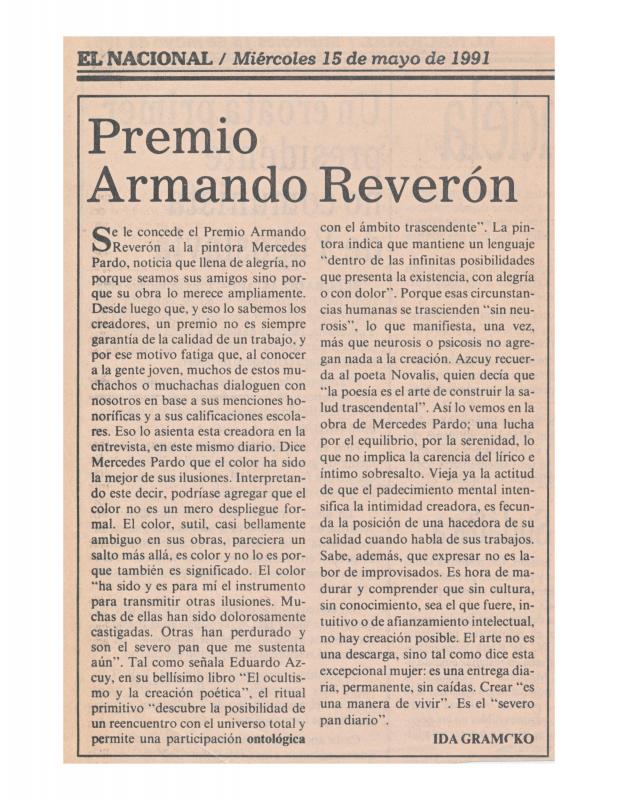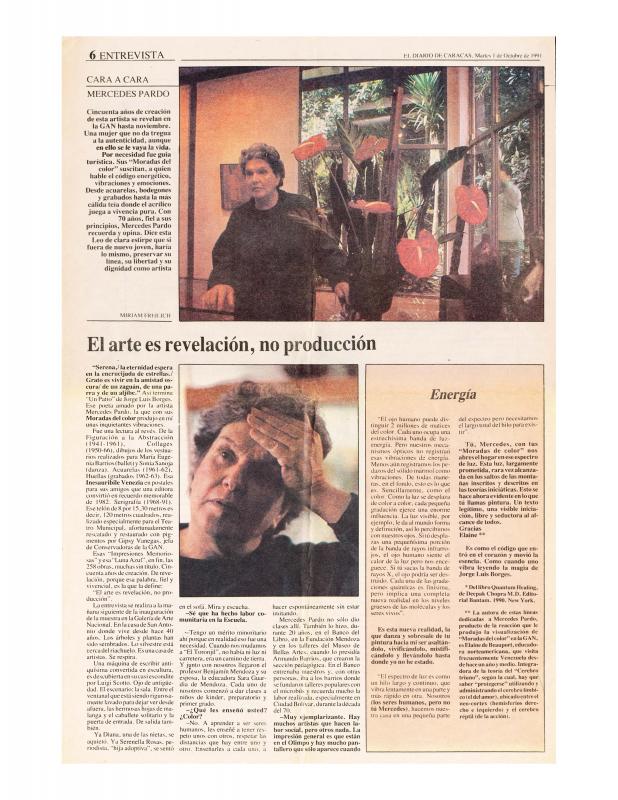The article appeared in “Cero a la Derecha,” a column that the author wrote first for El Nacional, and later for El Globo. As a prominent figure of Venezuelan literature and journalism, Ida Gramcko (1924–1994) does not provide us with an ordinary review of an exhibition, but introduces us to an intimate reading of the work of Mercedes Pardo (1921–2005), a pioneer of abstraction and incidentally her friend. Unlike the vast majority of articles on the Venezuelan painter, this review of Inesauribile Venezia, tredici variazioni sul tema does not aim to interpret Pardo’s approach to form or color. Instead, it concentrates on the feelings that inspired Pardo to make this album. In 1982, she was in Venice to accompany Alejandro Otero (1921–1990), fellow leading practitioner of Venezuelan abstraction and her husband, who was representing his country at the XLIII Biennale di Venezia. Inesauribile… is a collection of Pardo’s depictions of the Venetian cityscape in a postcard format and with a collage approach by mixing printed and painted material. In the article, Gramcko wonders why these were not sent as postcards and were collected in an album instead. The author explains the choice as a nostalgic sign that the painter is a dreamer, and quotes the French philosopher Gaston Bachelard to discuss the poetics of daydreaming, the difference between dreaming and daydreaming, and its links with memory and homesickness. As a matter of fact, Pardo was advised against sending these works through mail by Fausta Squatriti (b. 1941), an Italian writer and visual artist herself who selected thirteen of her Venetian works and gathered them into an album that the artist designed. These are the works presented at the Caracas Galeria Sagitario a year later, in 1983. The album would later be exhibited at her famous retrospective Mercedes Pardo: Moradas del Color, held in 1991 at GAN (Galeria Nacional de Arte) in the capital city.
Pardo was a pioneer of abstract art in Venezuela. Her artistic proposal spanned different approaches to abstraction, including both the lyrical spectrum and an Informalist attitude, as well as experimentations in the more geometric, hard-edge approach. The experimental approach of her art production is confirmed by her choice of supports, techniques, and materials. Although the works discussed in this article are small-scale collages, Pardo’s body of work includes large-scale public works, theatrical set designs, oils and acrylics on paper and canvas, and stained glass. Such experimentations have been frequently discussed in her literature as different ways to express the core element of her creativity: color.
[Ida Gramcko’s writing contributes to the literature on Pardo by highlighting the poetic and transcendental nature of her work. See also in the ICAA Digital Archive: Ida Gramcko, “Premio Armando Reverón” (doc. no. 1331139). For further detail on the show Mercedes Pardo: Moradas del Color, where the album Inesauribile Venezia was exhibited, see Gloria Carnevali, “El Espacio en la pintura de Mercedes Pardo” (doc. no. 1102285); María Fernanda Palacios, “Pintura y vida” (doc. no. 1102253); and Miriam Freilich, “El arte es revelación, no producción” (doc. no. 1325266).]




